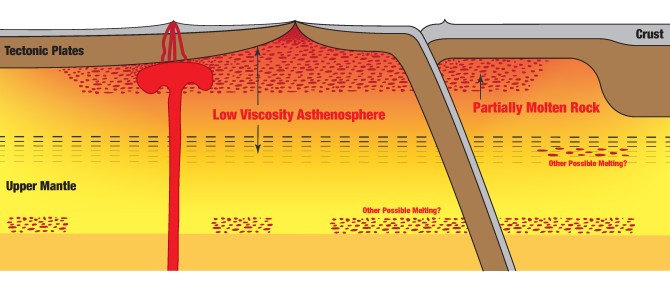News directly from Cornell's colleges and centers
Scientists detect global layer of melt hidden below Earth’s tectonic plates
By Syl Kacapyr
Scientists have detected a layer of melted rock encircling the Earth below its tectonic plates. Patches of the layer were known to exist, but a new study by a group of universities including Cornell has for the first time revealed its global extent.
Lying at a maximum depth of about 100 miles and with temperatures exceeding 2,600-degrees Fahrenheit (1,400 Celsius), the searing rocks are embedded within a region of weak material known as the asthenosphere, without which Earth’s upper layers would be too rigid for tectonic plates to move.
“Previous studies have suggested there could be a layer of melt in the asthenosphere, but the question is can we detect it globally, and besides seismic imaging, what other tools can be used to evaluate the global significance?” said study co-author Esteban Gazel, the Charles N. Mellowes Professor in Engineering in Cornell’s Department of Earth and Atmospheric Sciences. “What our study shows is that not only can we detect it globally in the seismic data, but it is consistent with the record stored in the chemical composition of lavas collected from the surface of the planet, and it’s widespread.”
Previous research had also suggested that molten rocks might help ‘soften’ the asthenosphere, like chocolate as it begins to melt. The new discovery, in fact, shows that it doesn’t.
“When we think about something melting, we intuitively think that the melt must play a big role in the material’s viscosity,” said Junlin Hua, a postdoctoral fellow at the University of Texas at Austin who led the research. “But what we found is that even where the melt fraction is quite high, its effect on mantle flow is very minor.”
Published Feb. 6 in the journal Nature Geoscience, the findings shed new light on the asthenosphere, which controls the physical properties and the landscape evolution on Earth, according to Gazel.
“Without the asthenosphere, we wouldn’t have plate tectonics, mountains or continents,” Gazel said. “You also need this boundary to be able sustain the subduction of tectonic plates that produces volcanoes, which in turn forms the atmosphere and builds the continental crust rich in nutrients like phosphorus that are critical to planetary habitability.”
Added co-author Karen Fischer, professor at Brown University who was Hua’s Ph.D. advisor when he began the research, “This work is important because understanding the properties of the asthenosphere and the origins of why it's weak is fundamental to understanding plate tectonics.”
The idea to look for a new layer in Earth’s interior came to Hua while studying seismic images of the mantle beneath Turkey as part of a research project at Brown University, where he was a doctoral student at the time.
After meeting each other at a Gordon Research Conference, Hua and Gazel began working together to integrate data from seismic imaging with the chemical record of volcanic rocks from a global asthenospheric database. They found that the evidence of partly molten rock that Hua had originally taken to be an anomaly was in fact commonplace around the world, appearing wherever the asthenosphere was hottest.
“Because we can put seismic data together with the petrological data, we have two completely separate sets of data that agree and are telling us that there is global layer of melt below the tectonic plates” Gazel said.
Another finding was that when the melt maps were compared with seismic measurements of tectonic movement, there was no correlation, despite the molten layer encompassing almost half the Earth. This suggests that the molten layer has little effect on the dynamics between the asthenosphere and tectonic plates.
“We cannot drill deep down to the asthenosphere, but we can illuminate that part of the planet using seismic imaging and the chemical compositions of samples that came from the deep Earth, just as a medical doctor would use a sonogram and blood chemistry to determine the condition of a patient,” Gazel said, “Through this study, not only do we have a much better understanding of the internal dynamics of the planet, but also the physical properties of a boundary layer that really is critical for everything, including life on Earth.”
The research was funded by the U.S. National Science Foundation.
Syl Kacapyr is associate director of marketing and communications for the College of Engineering. This article was adapted with permission from a version published by the University of Texas at Austin.
Media Contact
Get Cornell news delivered right to your inbox.
Subscribe

